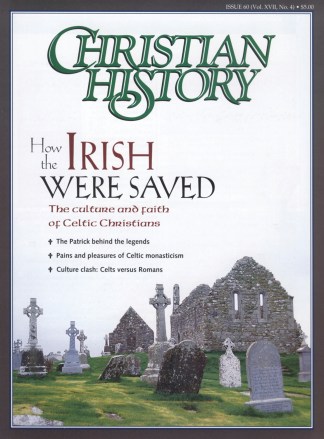Ann. 793—In this year dire forewarnings came over the land of the Northumbrians and miserably terrified the people; these were extraordinary whirlwinds and lightnings, and fiery dragons were seen flying in the air. A great famine soon followed these omens; and soon after that, in the same year, the havoc of heathen men miserably destroyed God’s church on Lindisfarne.”
The “miserable heathen” portrayed in this account from the Anglo-Saxon Chronicle were the Vikings. Popular legend portrays them as swift, merciless marauders; pagans who attacked the holy places of Ireland, Scotland, and elsewhere without regard for anything but accumulating wealth. No wonder Celtic monks prayed regularly, “From the fury of the Northmen, O Lord deliver us.”
In the late eighth century, Ireland was a land of petty chieftains, all of whom fought vigorously and frequently to become High King. Ireland’s economy had not yet risen above that of a pastoral society, and it possessed no true towns or cities.
It did, however, possess monasteries—lots of them. Not merely religious havens, they were miniature towns and centers of economic and political power. In fact, they functioned as the main financial institutions of their time, repositories for the priest-kings. Rivalry between tribes meant these repositories were plundered repeatedly, long before any Viking raiders appeared.
Archaeologist Magnus Magnusson explains, “A short experience of the country would have taught even a freelance Viking band that a raid on an Irish monastery was a sound economic proposition.” Thus in 793, they performed their first recorded raid on a monastery: Lindisfarne.
At first, the Vikings held a raiding season, from May to September each year, then returned home to winter in Norway. Over a 25-year period, 26 important attacks were recorded in the Irish Annals alone. Many more went unrecorded. In addition, rich or important Christians were held for ransom or sold into slavery.
Eventually, the Vikings began to settle (their original motive for exploring the region). By the 830s, the Northmen targeted larger inland monasteries and set up settlements in Ireland. They attacked Armagh and took Forannán, its abbot, captive along with Saint Patrick’s relics. Forann‡n returned, with the Patrick relics, the next year—no doubt having been ransomed at great expense.
In time, Viking longphorts (fortresses) like Dublin and Limerick became thriving centers of international trade, nurtured by Viking merchants. These Scandinavian merchants and warriors helped create the first true towns in Ireland, which lifted Ireland out of a purely pastoral economy.
Eventually, the Northmen integrated into Irish society. The pragmatic Vikings, seeking trade with increasingly Christian nations, followed the Irish into Christianity. They began to endow their children with Irish names. Though raids continued for another half-century, by the late 800s, Vikings had become permanent inhabitants of Ireland.
Georgia Beaverson is a writer from Madison, Wisconsin, and owner of the Green Linnet Workshop for writing and editing.
Copyright © 1998 by the author or Christianity Today/Christian History magazine. Click here for reprint information on Christian History.










